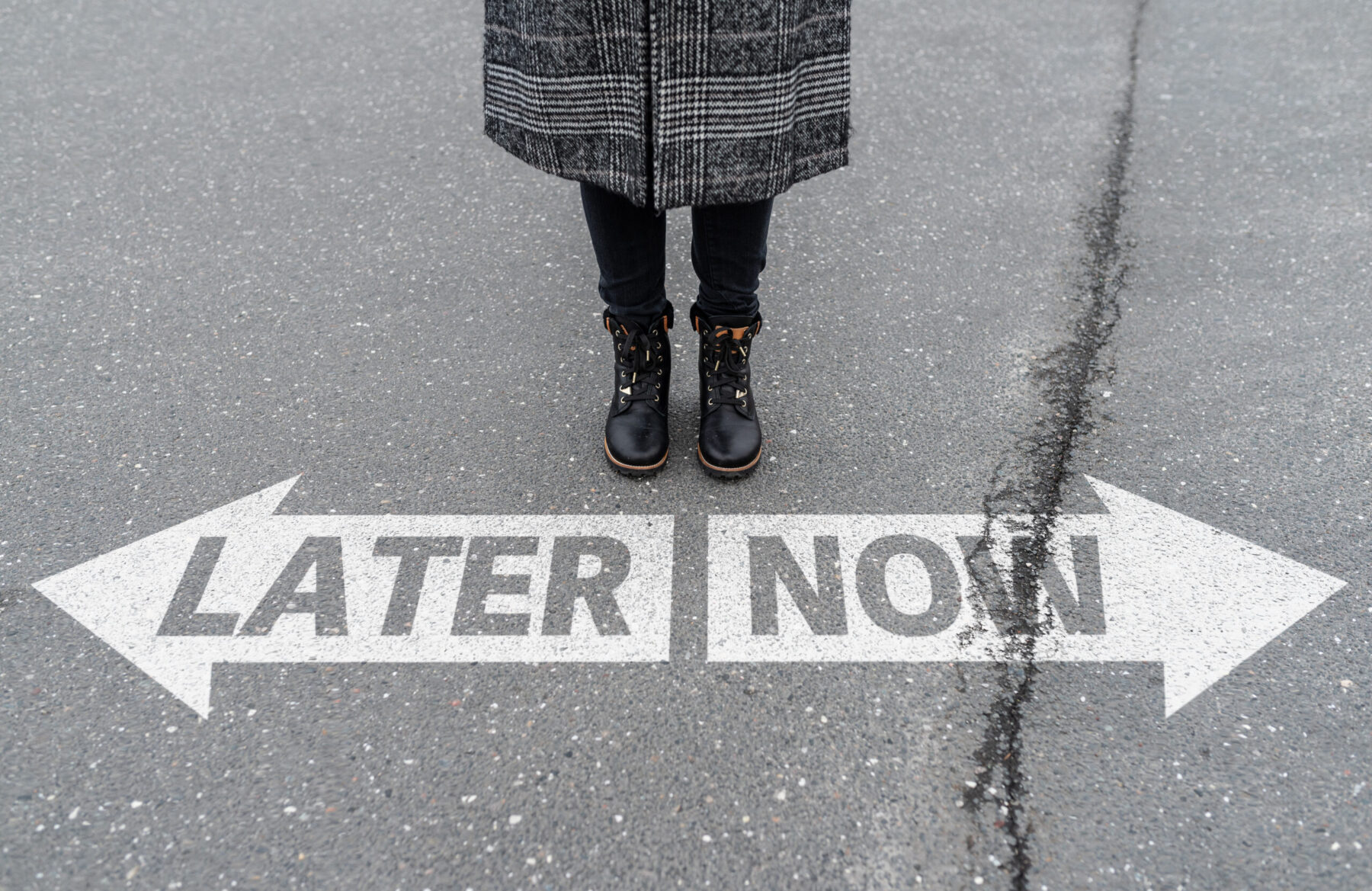In my last article, I introduced the idea of delay discounting – the psychological tendency to undervalue events in the future and overvalue events in the present. We explored how this can affect our daily work decisions, especially in relation to temptations, and introduced “Ulysses contracts.” Here we further explore Ulysses contracts and the supports we can put in place to focus on the work we care about.
Precommitments, Elizabeth Carter’s Bell, and Twyla Tharpe’s Morning Ritual
Once we are honest with ourselves that, just like yesterday and today, there are going to be temptations tomorrow, we can use Ulysses contracts to pre-commit to specific actions that are in line with our goals. These plans need to be in place before we want to do the work, so that both the work and temptations are still in the future, when both are delay discounted. With both in the future, what we value most is clear and we can plan accordingly. As Dan Ariely says in his book Predictably Irrational: “… although almost everyone has problems with procrastination, those who recognize and admit their weakness are in a better position to utilize available tools for precommitment and by doing so, help themselves overcome it.” (Ariely, 2010, p. 146).
When I was pregnant with my son, I wanted to commit to weekly physical activity, but I knew from my track record that this would be difficult. I was still relatively junior in my tenure-track appointment at the time, and the work hours seeped into all available spaces. There was a pre-natal yoga class on offer not too far from the university and the teacher provided both the drop-in and full-term payment options. I knew that the drop-in option would see me there once, never to return again. So I paid for all 12 classes up front. Committing in advance to a specific day and time each week made it so much easier to keep the commitment. Having paid for everything in advance also provided an incentive to get the most out of it. I am much more active now than I was then, but rarely on my own. I so admire the faithful solo exercisers, but I also know that I am not one of them. Instead of pretending that tomorrow will be different, I make a point of booking outdoor walks and hikes with my friends and family so that I stay active on a regular basis.
Similar to the Ulysses contract of meeting someone on a trail or at the gym, we can also incorporate these types of precommitments in our work. I know from my student days how often practice requirements can be in a tug of war with a person’s willpower all day long. And I dearly wish that I had heard about delay discounting and precommitment a little sooner, since it would have meant a lot of earlier nights! But now, as much as is feasible in my job, I try to practice at set times each day. Knowing when I will practice in advance takes away the tug of war, because the decision has already been made. It’s non-negotiable.
As important for me as the precommitment is, choosing the right times to practice is as important. I have come to learn that it is hard to transition to just about anything once I am swept up in the computer’s black hole. So I schedule practice sessions to follow moments when I will already be in transition. Most often this is right after breakfast (with another precommitment not to check any messages beforehand), after lunch, and after I put my son to bed. Practicing right after these transitional moments reduces the activation energy required to get going. If I am getting up from eating, I have to walk somewhere else regardless, so it is just as easy to walk to the practice room as it is to walk to my computer. Going to the computer first wastes this transitional moment, since going to the computer after practicing is a much easier transition than the reverse. I have often tried to fight this, convincing myself that I can overcome the computer’s pull and leave to practice in 15 minutes. And sometimes I can. But more often than not I end up surprising myself once more by just how powerful delay discounting can be.
I find it fascinating to read about how other artists have overcome delay discounting, incorporating various Ulysses contracts. Mason Currey’s books, Daily Rituals (2013), and the sequel, Daily Rituals: Women at Work (2019), have been especially illuminating. I felt a particular kinship with the writer Elizabeth Carter (1717-1806) and her morning routine. She had a bell installed at the head of her bed, with a long string leading outside into the garden below. Every morning, the Sexton who maintained the church would ring the bell “…with as much heat and goodwill as if he was ringing my knell.” No pressing snooze on that contraption! She goes on to say, “Some evil-minded people of my acquaintance have most wickedly threatened to cut my bell-rope, which would be the utter undoing of me; for I should infallibly sleep out the whole summer” (Carter’s memoirs as cited in Currey, 2019, p. 236). Carter was also known for working in small 30-minute bursts throughout her life – an approach that got me through writing my dissertation.
In another one of my favourite books, The Creative Habit, celebrated choreographer Twyla Tharp shares her pre-committed ritual:
I begin each day of my life with a ritual; I wake up at 5:30 A.M., put on my workout clothes, my leg warmers, my sweatshirts, and my hat. I walk outside my Manhattan home, hail a taxi, and tell the driver to take me to the Pumping Iron gym at 91st street and First Avenue, where I work out for two hours. The ritual is not the stretching and weight training I put my body through each morning at the gym; the ritual is the cab. The moment I tell the driver where to go I have completed the ritual.
It’s a simple act, but doing it the same way each morning habitualizes it — makes it repeatable, easy to do. It reduces the chance that I would skip it or do it differently. It is one more item in my arsenal of routines, and one less thing to think about (Tharp, 2006, p. 14-15).
Beyond precommitment, we also have to be mindful about what we are committing to. Some years ago, I made the seemingly obvious realization that when I commit to something, I am simultaneously saying no to everything else that I could be doing during this time. While saying no is still a real struggle, this consciousness can help with setting priorities. Even if something will only take an hour, if it’s an hour that will be taken away from an important project or time with my son, I have to really think about whether or not it is worthwhile.
Facing Temptations
In addition to pre-committing to what is valuable to us, we can also set supports in place that will interfere with possible distractions or temptations. Interestingly, we can turn to pigeons for some help with this.
In one of the seminal studies on delay discounting and preference reversals, psychologist George Ainslie (1974) studied whether pigeons could learn how to control their impulses. Pigeons were offered a small immediate food reinforcement or a delayed larger food reinforcement. Not surprisingly, pigeons preferred the immediate food reinforcement, even though it was much smaller. However, when a red button was introduced that would turn off their ability to accept the small immediate food reinforcement, forcing them to wait for the larger later reinforcement, some of the pigeons started to use this. When the button did not serve this purpose, the pigeons did not use it. Somehow, they must have realized the benefit of interfering with their immediate gratification impulse.
Willpower is finite and we need our own red buttons, just like the pigeons. In the same way that we can use Ulysses contracts to commit to our work, we can use other forms of pre-commitment to prevent us from giving into our immediate gratification impulse.
One of the most important red buttons I use is the internet-blocking application called “Freedom.” I use this program to pre-commit to stretches of time when I don’t want to be online. As I mentioned previously, I use physical transitions to practice, but once I land at the computer it’s hard for me to leave, especially at night. So I use precommitted block-out windows on Freedom to take care of this job for me. I don’t have to think about when I am going to stop. I know that there is a hard cut-off time and, if I miss it, the big butterfly logo is going to show up and “set me free.” I am sure that there are many applications that carry out a similar function. When I was searching for something like this, my one need was that I could pre-commit to a repeating schedule in advance. Some programs require that you decide in the moment to shut down website access. For me this need for an in-the-moment choice defeated the purpose. I don’t want to use up my limited willpower. I want the decision to be made for me.
I was heartened to read about novelist Zadie Smith’s struggle with digital distractions in Mason’s Currey’s Daily Rituals sequel, mentioned above. In her 2012 novel NW she actually thanked Freedom and another internet-blocking software, SelfControl, for helping her clear the time to write (Currey, 2019, p. 224). She also may be one of the few other people aside from myself under the age of about eighty who does not own a smartphone. In a conversation with Slate, the interviewer suggests that this is a bold move. She passionately disagrees. “I still have a laptop, it’s not like I’m a nun, I just don’t check my email every moment of the day in my pocket” (Chotiner, 2016).
Since the vast majority of people do own smartphones, red buttons are all the more important, especially in the practice room. Some musicians have success with the kinds of internet-blocking applications I mention above. Others find that airplane mode is enough. And still others know that they need to leave their phones outside of the practice room. Recent research indicates that “even when people are successful at maintaining sustained attention – as when avoiding the temptation to check their phones – the mere presence of these devices reduces available cognitive capacity” (Ward et al., 2017, p. 140). Working memory capacity and fluid intelligence both seem to suffer when people have their phones with them, even if the phones are out of site in a pocket or bag (although the detrimental effect is larger when the phones are in view). Despite experiments showing this impact on cognitive processing, it’s noteworthy that participants in the studies did not realize that their performance was affected by their cellphone location (Ward et al., 2017). In light of this research, it is worth trying to keep cellphones at least out of view when we are working. And if we want to leave phones outside of our practice rooms, we can use other devices instead for the digital applications we value in practice. I use a disconnected iPod for this purpose and still tend to use my separate metronome/tuner and Zoom recorder much of the time.
A few years ago, I noticed an unlikely distraction – the time. Without a cellphone, I carry around a little portable digital alarm clock as my source of time. I used to always keep this on my table facing out while practicing. I started to realize that I was looking at this clock a lot and that this was interfering with my ability to get deep into practice. I have heard the same from cellphone users who frequently press the phone to check on the time. I still keep track of when I practice each day, so I need the clock, but now I turn it around as soon as I start. I tend to have a rough idea of how much time has passed and I set an alarm when I need a hard stop. The time goes by so much faster when I am not watching it. I had a similar realization with open email windows while writing. I noticed myself looking at the inbox all the time. Now I make sure my email is closed when I write, and I often use timers or Freedom to pre-commit to a certain length of writing without checking my email.
Final Inspiration from a Frog, a Toad, and a Hungry Pig
I love the children’s stories by Arnold Lobel. And the “Frog and Toad” series is a real favourite in our household. There is one story called Cookies, in which Toad shows up at Frog’s house with a large bowl of delicious cookies. They can’t stop eating them, despite their best efforts.
‘We must stop eating!’ cried Toad as he ate another.
‘Yes,’ said Frog, reaching for a cookie, ‘we need will power.’
‘What is will power?’ asked Toad.
‘Will power is trying hard not to do something that you really want to do,’ said Frog.
‘You mean like trying not to eat all of these cookies?’ asked Toad.
‘Right,’ said Frog (Lobel, 2014, p. 100-101).
The duo starts devising various ways to interfere with their cookie eating. First, they put all of the cookies in a box. Realizing that they can just open the box, they tie string around the box. Then they put the box up on a high shelf. Finally, Frog throws all of the cookies to the birds. “’Now we have no more cookies to eat,’ said Toad sadly…’Yes,’ said Frog, ‘but we have lots and lots of willpower.’” (Lobel, 2014, p. 106-107). And then Toad goes home to bake a cake. Cake aside, this is a charming illustration of a Ulysses contract in action.
Arnold Lobel clearly understood the true nature of willpower. In one of his fables, The Pig at the Candy Store, a pig is similarly tempted. He dreams all night about candy. When he awakes, he rushes out the door and heads toward the candy store. When he gets there, however, the store is closed. Not having eaten a single bite of candy the pig exclaims, “What wonderful willpower I have!” The author’s moral of the story then reads: “A locked door is very likely to discourage temptation” (Lobel, 1980, p. 31).
Where There Is a Way There Is a Will
We are often told that “where there is a will there is a way.” But I now believe the opposite to be true. Where there is a way there is a will. Waiting to feel some sort of magical motivation spark is rarely what gets the big work done, because it’s not reliable. Delay discounting is at the ready to interfere. It’s the daily precommitments, habits, and red buttons that clear the path for work. Then motivation is free to follow.
I will leave you with some final words from Dan Ariely:
We have problems with self-control, related to immediate and delayed gratification – no doubt there. But each of the problems we face has potential self-control mechanisms. If we can’t save from our paycheck, we can take advantage of our employer’s automatic deduction option; if we don’t have the will to exercise regularly alone, we can make an appointment to exercise in the company of our friends. These are the tools that we can commit to in advance, and they may help us be the kind of people we want to be. (Ariely, 2010, p. 147).
References
Ainsley, G. (1974). Impulse Control in Pigeons. Journal of the Experimental Analysis of Behaviour, 21(3), 485-489
Ariely, D. (2010). Predictably Irrational: The Hidden Forces that Shape our Decisions. New York: Harper Perennial
Chotiner, I. (2016, November 16). Zadie Smith on Appropriation, Male Critics, and How Trump Interests Her Novelistically, September 02, 2020
Currey, M. (2019). Daily Rituals: Women at Work. New York: Alfred A. Knopf
Lobel, A. (1980). Fables. New York: Harper Collins Publishers
Lobel, A. (2014) Frog and Toad: Storybook Favorites. New York: Harper Collins Publishers
Tharp, T. (2006). The Creative Habit: Learn It and Use It for Life. New York: Simon & Schuster
Ward, A., Duke, K., Gneezy, A. & Bos, M. (2017). Brain Drain: The Mere Presence of One’s Own Smartphone Reduces Available Cognitive Capacity. Journal of the Association for Consumer Research 2(2), 140-154
Acknowledgements
I would like to thank Grace Shryock Johnson and Aaron Hodgson for providing such helpful feedback on the first draft of this article.
Citation Details
Carter, Christine. “Where There is a Way There is a Will: Overcoming the Procrastination Trap (Part 2).” The Curious Musician (October 2020). Retrieved from: http://christine-carter.com/blog/where-there-is-a-way-part-2/

The Curious Musician
by Christine Carter
Dr. Christine Carter is actively involved in performance psychology research, focusing on how musicians can be more effective on stage and in the practice room. Her research has led to a variety of article publications and invitations to give workshops at institutions around the world. She is a Visiting Scholar at Jessica Grahn’s Music and Neuroscience Lab.





